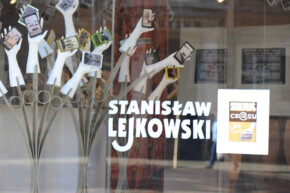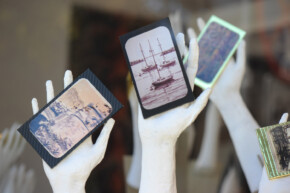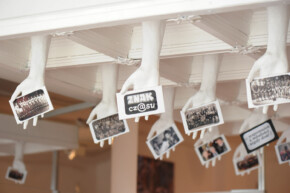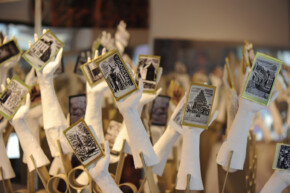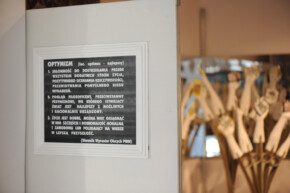60 years (or maybe 86) of optimism is Stanisław Lejkowski his life and his artistic work. One could believe this, in addition, he himself gave this subtitle to the exhibition. He’s a man full of zest for life, strength and humour. He’s got an enormous imagination, lots of ideas and is committed to the implementation of his objectives. He’s always had lots of orders — he designed numerous interiors of cafés, restaurants, cinemas etc. The interior of the Teatr Kameralny in Bydgoszcz (now defunct) is also his work. He designed the great wall paintings and small logos. He painted in the open air, and used to bring series of drawings from his travels around the world. It’s hard to tell what Lejkowski is unable to create. He can even do a monumental statue. And everything he does, he does precisely, using his really good manual dexterityI had the pleasure of watching him assemble the installation for the „Streets” exhibition. When he gave up arranging interiors and „retired”, he started creating spatial projects small architecture for galleries: Klonowanie I and II (Cloning I and II), Piramida (Pyramid). Korzenie narodowej tożsamości (Roots of the National Identity), Apokalipsa inaczej (Apocalypse in a different way). These are his thoughts on life, on the conditions of social, political and cultural nature, most often using the form of a mirror creating the illusion of space, and at the same time reflecting the face of the viewer.
In the „Sign of the Time” space mirrors appear as well. I don’t have a clear picture of that project, as it will get its final form in a couple of weeks. The author’s stories and drawings only hint at the organisation of his work at the gallery. „Sign of the Time” is a cellular phone, an object that these days rules almost every human being. From paper pulp, Stanisław Lejkowski formed sixty (a significant number for him this year) hands with forearms, life-size. Each hand holds a 15×9 cm phone. Then he doubled these forms of papier-mâché, but I don’t know how many of these are going to be shown at the exhibition. The screens of the phones show images from the life of Stanisław Lejkowski: the most important photographs – Memories of the youth are never enough…, as well as drawings from his journeys, book plates, paintings, drawings, images of Chełmno and Bydgoszcz, that is the works created from the heart, not ordered (the interior design projects were excluded).
„Sign of the Time” is in a sense the conversation of Stanisław Lejkowski with Stanisław Lejkowski; for his conversations with the past, the artists used the most important device for the majority of people today, the only source of information for many. The audience is going to be assaulted with information and the artistic form of a hand with the phone duplicated in the mirrors surrounding the gallery. The person who starts talking on the phone, will see their multiplied figure with mobile phone in hand this view will complement the exhibition and creative plan of Stanisław Lejkowski will be accomplished.
Elżbieta Kantorek, July 29th, 2015
Stanisław Lejkowski was born in 1929 in Chełmno on the Vistula, where he attended the primary school and Junior High School. Graduate of the State High School of Fine Arts in Bydgoszcz. In 1950-1955, he studied at the Faculty of Fine Arts of the Nicolaus Copernicus University in Toruń: Graphics (Prof. Jerzy Hoppen, Prof. Edward Kuczyński), the Faculty of Monument Science and Conservation of Architecture and Sculpture (Prof. Jerzy Remer), Artistic and Didactic Section, Interior Design (Prof. Stefan Narębski), Composition of Solids and Planes (Prof. Józef Kozłowski), Stained Glass Art (Edward Kwiatkowski), Drawing and Anatomy (Prof. A. Dargiewicz). Author of numerous realised projects of public buildings: theatres, restaurants, movie theatres, coffee shops, community centres, office interiors and exhibition stands. Designer or co-designer of memorials in Bydgoszcz, Chełmno, Rudzki Most near Tuchola. Designer of furniture, sgraffito, ceramic mosaics, murals etc. Author of posters, advertising paintings, logos. Until now he does commercial design, workshop design, painting. Author of spatial projects honoured with the audience prize, presented in the Municipal Gallery bwa in Bydgoszcz during the subsequent editions of Biennial of Bydgoszcz Art: Cloning I and II (1998), Pyramid. Roots of the National Identity (2000), Apocalypse in a different way (2002). Originator, author and arranger of his retrospective exhibition, „Wszystko ma swój czas” (There is Time for Everything), realised in the Municipal Gallery bwa in Bydgoszcz (2007) and in the Museum of Chełmno Region (2009)
exhibition for the 60th anniversary of artistic work


